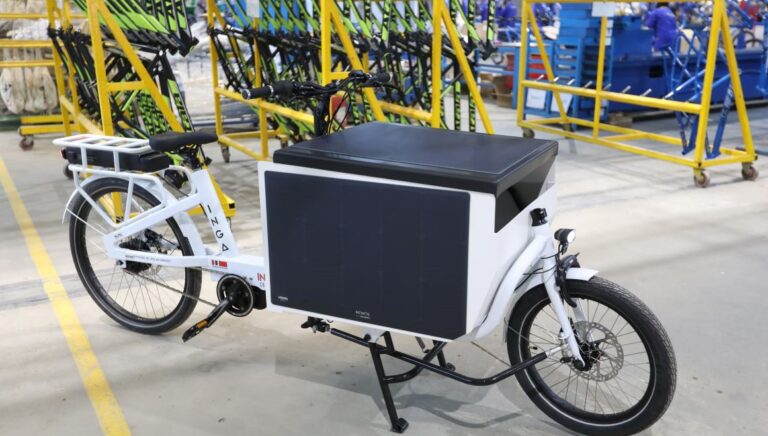Infinite Mobility, a developer of solar-powered bicycles for last-mile vans and commuters, is shipping samples to potential distributors in Europe a month before series production.
Norway’s Infinite Mobility, a startup developing lightweight electric vehicles, is shipping prototypes of its first PV-powered two-wheeler cargo bikes to selected bike shops in Europe. The potential distributors will provide feedback to the Infinite team ahead of series production, which will begin next month at the assembly plant in Tunisia.
The first model to be launched is an electric two-wheeler, called Inga. It has a top speed of 25 km/h and is equipped with 160 W of semi-flexible PV and an integrated 36 V lithium-ion battery. It supports a maximum load of 250 kg.
Three panels of Maxeon/Sunpower interdigitated back contact (IBC) solar cells are mechanically attached to the front cargo bed, one is horizontal and two are oriented vertically.
“We chose IBC cells because they are aesthetically pleasing yet powerful enough for the application. In fact, there is a very good match between the energy harvested from solar energy and the energy required to power the bicycle,” Infinite Mobility founder and CEO Moez Jomâa said. pv magazine.
The Inga model has a 100 Nm hub motor integrated into the frame, manufactured by the Danish e-motor company Promovec, and a gear system sourced from the Dutch bicycle technology company Enviolo. The 16.5 Ah battery has a range of 60 km per charge.
“A full day in the sun is enough to charge the battery from zero to full. One hour is enough for at least 8 km of driving,” says Jomâa. “Our solar cargo bikes are made to significantly minimize battery charging via the electricity grid. For example, we are thinking of commuters who can park in the sun while working.”
According to Jomâa, the initial tests are encouraging, citing a full year of test data collected by the team. “Of course it is solar energy, so actual performance may vary depending on irradiation, proximity to the equator and season. But in our target markets of Germany, the Netherlands, Switzerland and Austria, the battery can last many months in spring and summer without charging from the electricity grid,” Jomâa said.
INGA owners can track their own performance, monitor battery status and receive advice on optimized energy harvesting through software provided by the company in an app.
Looking ahead, Jomâa will arrange financing for production and prepare to launch a second product, a three-wheeled cargo bike with much larger storage capacity and up to 550 W of integrated PV.
The electrification of last-mile transportation and urban micromobility creates new opportunities for developers of integrated solar PV systems pv magazine has reported, such as charging stations for e-scooters or electric pick-up trucks equipped with integrated solar-powered medical systems.
Image: Infinite mobility
This content is copyrighted and may not be reused. If you would like to collaborate with us and reuse some of our content, please contact: editors@pv-magazine.com.


